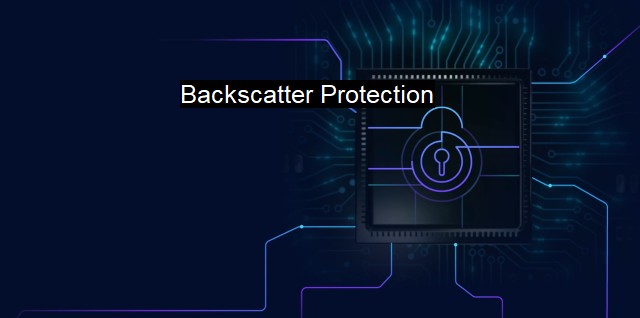What is Backscatter Protection?
Staying One Step Ahead of Cyber Threats with Antivirus software: Understanding the Importance and Function of Backscatter Protection
Backscatter Protection is a highly critical aspect of cybersecurity measures and antivirus systems that protects a network or server from indirect or 'backscatter' attacks. It is also identified as misdirected bounce, outscatter, or collateral spam. In understanding Backscatter Protection, it’s necessary to define what backscatter is first.Backscatter typically refers to unsolicited and reflexively sent email messages that bounce back in response to spam emails. Spammers frequently forge return email addresses when they send out bulk emails. An innocent third-party’s email could be used as the forged address, leading to them receiving responses to spam email. This method falsely multiplies the refractions of spam, taking advantage of a system's natural method of handling message non-delivery, overpowering dragonfly-like around the Internet's ethernet cables instead of solely bouncing back to the sender. This orchestration is achieved via exploiting mail servers that do not have effective backscatter protection measures in place.
Backscatter Protection mitigates this by identifying and blocking spam-originated messages. The defensive software scrutinizes incoming replies and identifies patterns that hint at spam, such as traffic originating from a particular IP address or an extraordinary surge in incoming bounced emails in a short period. Backscatter Protection can then mark this activity as suspicious and block it, providing efficient handling of the indirect hack.
Backscatter Protection is paramount in running a reputable email service and is crucial for organizations that host email services or communicate frequently by email, as backscatter attacks can quickly overwhelm server capabilities, causing significant downtime, productivity losses, and damage to the servers. Therefore, backscatter protection should be part of an organization's comprehensive cybersecurity strategy.
Arguably the most significant benefit of Backscatter Protection is the potential to conserve valuable network and cyber resources by cutting down on unnecessary server load and bandwidth wastage. Rather than wasting these resources on delivering bounce-back emails resulting from a spammer’s fraudulent network activity, the system can prioritise real, relevant, and beneficial network traffic. So, the bounce loops that undelivered spam items generate could be wholly eliminated.
Backscatter doesn't necessarily relate to spam only. It applies to a broader spectrum where numerous unsolicited network traffic responses are sent to unsuspecting IP addresses. It’s a practice adopted in Distributed Denial of Service (DDoS) attacks where the hacker's IP address is disguised and bombards a victim's servers from seemingly many different sources.
Primarily known for its role in email security, Backscatter Protection services also work in the broader cybersecurity sphere, helping manage the risks associated with DDoS attacks. It does this by scrutinizing traffic, spotting suspicious-looking backscatter patterns, and blocking them similarly.
a noteworthy point concerning Backscatter Protection is its reliance on domain-level authentication technology for effective functionality. Explicitly, it requires Domain-based Message Authentication, Reporting, and Conformance (DMARC), Sender Policy Framework (SPF), and Domain Keys Identified Mail (DKIM) to validate incoming messages' identities. If a message fails in both filters, the software treats the associated IP as risky and flagged for potential spamming activities.
Backscatter is when unsolicited email responses are reflected and scattered across the network, often in layers, by delinquent servers or hackers. Backscatter Protection is the safeguarding strategy adopted to rid networks of this malpractice. It is an indispensable part of any cybersecurity initiative, working alongside broader protective measures to secure servers from both direct and indirect malintent cyber activities. By decreasing unnecessary traffic and utilizing stringent validation filters, Backscatter Protection is a powerful tool for modern organizations, ensuring efficient and safer digital communication lines.

Backscatter Protection FAQs
What is backscatter protection?
Backscatter protection is a cybersecurity mechanism that prevents spammers from using forged email addresses to send spam or phishing emails. It works by blocking or filtering incoming messages that appear to have originated from non-existent or unverified email domains.How does backscatter protection differ from antivirus software?
Backscatter protection and antivirus software serve different purposes. Backscatter protection aims to prevent email-based spam and phishing attacks that use fake sender addresses, while antivirus software protects computer systems from malware attacks that can occur through various channels, including email, web browsing, or file downloads.Can backscatter protection block legitimate emails?
In some cases, backscatter protection can mistakenly block legitimate emails that are sent from legitimate but unverified email domains or use certain email authentication methods. However, modern backscatter protection solutions employ advanced algorithms and techniques to minimize false-positives and ensure that legitimate emails are delivered without delay or interference.Do I need backscatter protection for my business?
If your business receives a significant amount of email traffic and wants to reduce the risk of email-based spam, phishing, or malware attacks, then backscatter protection can be a useful tool. However, the specific needs and requirements for backscatter protection may vary depending on the size, industry, and email usage patterns of your business, so it's essential to evaluate your options and consult with cybersecurity experts before implementing any new security measures.| | A | | | B | | | C | | | D | | | E | | | F | | | G | | | H | | | I | | | J | | | K | | | L | | | M | |
| | N | | | O | | | P | | | Q | | | R | | | S | | | T | | | U | | | V | | | W | | | X | | | Y | | | Z | |
| | 1 | | | 2 | | | 3 | | | 4 | | | 7 | | | 8 | | |||||||